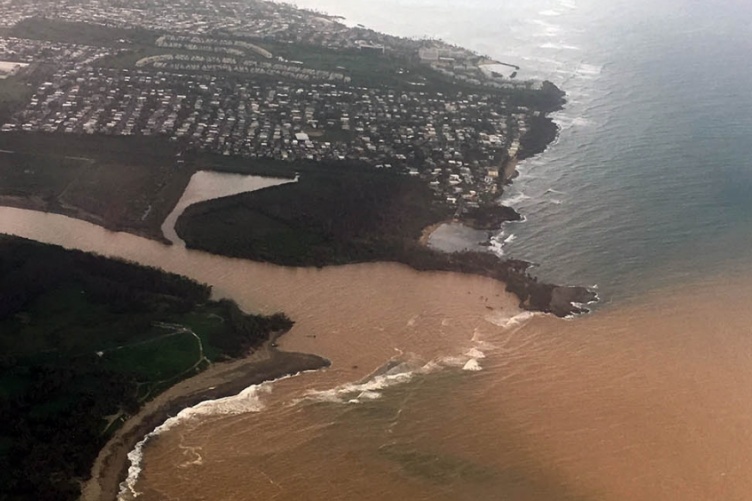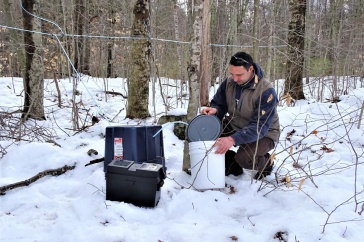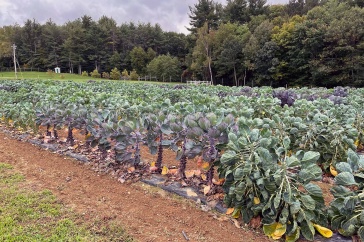
Scientists found similarities in how solutes such as salt were exported from different watersheds, but differences in how sediment, such as sand and silt, responded to the storm.

Large, extreme events such as hurricanes and superstorms are becoming more frequent under a changing climate. Researchers with the New Hampshire Agricultural Experiment Station at the University of New Hampshire are looking to new findings from a major hurricane in Puerto Rico to understand how large storms may affect New England watersheds, streams, and river networks.
“New England, including New Hampshire, often receive significant precipitation due to hurricanes that travel up the Eastern seaboard. While the region’s terrain and vegetation are different compared with Puerto Rico, these results give researchers an initial predictive framework to understand local watersheds,” said Adam Wymore, research assistant professor of natural resources and the environment.
New Hampshire has a history of extreme rainfall events, including category four and five hurricanes Gloria, Donna, Esther, and Floyd, and superstorm Sandy. “Understanding how a watershed responds to significant precipitation events is key to understanding how local stream and river networks will be affected by these storms. This has implications for our local estuaries and coastal shorelines,” Wymore said.
Wymore, William McDowell, professor of environmental science and researcher with the New Hampshire Agricultural Experiment Station, and their colleagues at the University of Pennsylvania and U.S. Geological Survey conducted experiments in the tropical Luquillo Mountains of Puerto Rico.
Researchers used high-frequency sensors, a new technology, to assess stream chemistry at 15-minute intervals before and during Hurricane Maria, a category five hurricane that hit Puerto Rico in September 2017. Their goal was to learn how and where solutes such as salt and sediment such as sand and silt are stored in watersheds and how these reservoirs respond to such massive storms. The results could provide valuable information to water resource managers.

as this one to assess stream chemistry at 15-minute intervals before and
during Hurricane Maria,
In one of the first research projects to use these sensors in remote areas and during a major hurricane, scientists found similarities in how solutes such as salt were exported from different watersheds, but differences in how sediment, such as sand and silt, responded to the storm. They attribute these different responses in solutes vs. sediment export in different watersheds to unique interactions among biological, geological, and hydrological factors in specific watersheds.
In addition, researchers found watersheds had a unique response specifically to Hurricane Maria. Not only were solute and sediment exports more magnified, but the watersheds behaved differently during the storm. They found large amounts of sea salt and landslides caused the increase in solute and sediment export. These results may be important when assessing the impact of such storms on watersheds and estuaries near oceans since the Luquillo Mountains are a short distance to the Atlantic Ocean, similar to parts of New Hampshire.
Going forward, researchers plan to investigate how watersheds recovered from Hurricane Maria. Specifically, they want to know if watersheds immediately go back to normal behavior, how long it takes watersheds to recover after a major storm, and if these watersheds are resilient to such extreme events.
“Ultimately, freshwater ecosystem function is the result of in-stream processes, interactions with the terrestrial landscape, and climate. To fully understand how freshwater ecosystem function, we must take a holistic perspective and integrate all factors that work together to determine how freshwater ecosystem work and how they will respond to change,” Wymore said.
This new research is presented in Frontiers in Earth Science in “Hysteretic Response of Solutes and Turbidity at the Event Scale Across Forested Tropical Montane Watersheds” (DOI: 10.3389/feart.2019.00126).
This material is based upon work supported by the NH Agricultural Experiment Station, through joint funding of the National Institute of Food and Agriculture, U.S. Department of Agriculture, under award number 1006760, and the state of New Hampshire. Funding also was provided by the National Science Foundation’s Luquillo Critical Zone Observatory Program, the Luquillo Long-Term Ecological Research program, and the StreamPulse project; and the UNH CoRE program.
Founded in 1887, the NH Agricultural Experiment Station at the UNH College of Life Sciences and Agriculture is UNH’s original research center and an elemental component of New Hampshire's land-grant university heritage and mission. We steward federal and state funding, including support from the USDA National Institute of Food and Agriculture, to provide unbiased and objective research concerning diverse aspects of sustainable agriculture and foods, aquaculture, forest management, and related wildlife, natural resources and rural community topics. We maintain the Woodman and Kingman agronomy and horticultural research farms, the Macfarlane Research Greenhouses, the Fairchild Dairy Teaching and Research Center, and the Organic Dairy Research Farm. Additional properties also provide forage, forests and woodlands in direct support to research, teaching, and outreach.
-
Written By:
Lori Wright, '06G | NH Agricultural Experiment Station | lori.wright@unh.edu | 16038621452
















































